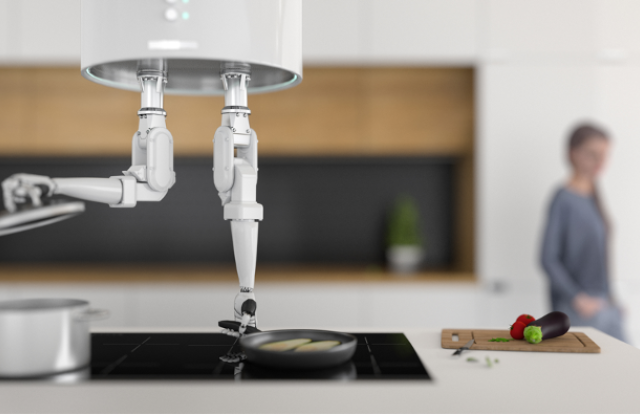Anaphora Unveiled: Tracking Culinary Transformation in the Tech-Driven Kitchen
Anna Morbiato, Venice International University.
In the dazzling realm where cutting-edge technology meets the world of culinary arts, precision is not just a preference – it's the secret sauce to success. Imagine a futuristic kitchen where robotic chefs whip up gourmet delights with a mere tap on a touchscreen. Now, in this technologically driven culinary landscape, the unsung hero emerges: accurate tracking of coreference. Like a culinary GPS, it navigates all complex recipe transformations undergone by ingredients, ensuring that every ‘it’ and ‘they’ (as in ‘put it in the fridge’ or ‘they are ready when a fork slides in easily’) points to the right flavour-packed entity. Let's explore why this seemingly subtle linguistic skill is the backbone of a seamless, tech-infused gastronomic experience.
Take a simple Italian pasta recipe step: 'Boil a pot of water, add some salt, then add your favourite pasta type. Once it's cooked, drain it and then add it directly to the tomato sauce.' While us readers have no doubt what 'it' refers to, it is not as straightforward for a machine to understand that 'it' refers to the pasta and not to other nouns like 'pot,' 'water,' or 'salt.' Still, it is crucial that the right item is added to the sauce for a successful execution of the recipe.
Accurate tracking of coreference becomes crucial in a technologically driven culinary landscape. But this comprehension comes with its set of challenges. Recipes are full of pronouns and other ways to refer to items, ingredients, and tools. However, these are sometimes far from transparent and often include not only pronouns, but also even zero anaphors (Ø) (namely using no words at all!). The same sentence as above could work also with no 'it': Boil a pot of water, put some salt, then add your favourite pasta type. Once Ø cooked, drain Ø and then add Ø directly to the tomato sauce.’ Not only ingredients, but also intermediate products of each step (resultant objects, like a mixture or a cream) are frequently left unmentioned, resulting in potential ambiguity. This phenomenon is not marginal; in fact, zero anaphors (also referred to as zero pronouns, null elements, or implicit entities) are more frequent in recipes as compared to other genres. This is especially evident in pro-drop languages like Italian and topic-drop languages like Chinese, where zero anaphora is widespread and often requires inference for correct interpretation. Further challenges include partial coreference phenomena (also known as bridging) as well as evolutive anaphors, namely linguistic expressions that refer to an entity while also indicating a change in its properties or attributes over time. Evolutive anaphors are very common in culinary narratives, where they typically refer to an ingredient or component of the recipe which, in the meantime, has undergone some transformation.
Imagine we want to make baked potatoes. The recipe starts by telling us ‘Wask and peel the potatoes.’ Then it goes on with the cooking procedure, which includes garlic, warm milk and butter. The last passage says: “Blend with a potato masher or electric mixer until potatoes are smooth and creamy.” For sure, the entity denoted by the term potatoes in the ingredients and that denoted by the same word in the last passage are very different. Then why do we still use the word potatoes? And why does it sound odd if we do the same in a sentence like ‘Juice the apples, then put them onto a pan.’?
Unravelling the complexities of anaphoric references in recipes is the objective of the paper ‘Pragmatics as the secret ingredient for NLP: a cross-linguistic study of reference tracking and evolutive anaphors’. The paper provides an in-depth exploration of coreference encoding and resolution in the domains of linguistics and Natural Language Processing, with a particular emphasis on zero pronouns, partial coreference phenomena, and evolutive anaphors. Additionally, it presents an analysis of the flow of information in recipe texts, as well as of the type, frequency, and nature of anaphoric devices used in authentic recipes drawn from food blogs. It considers texts in English, Italian, and Chinese, which significantly vary in terms of coreference tracking mechanisms and demonstrate different levels of dependence on zero anaphors and inferential processes. The paper gives particular attention to evolutive anaphors and the role played by inference and world knowledge in coreference disambiguation. Recall the pasta recipes above: the pronoun it involves a change in properties of the pasta, from being hard to being soft after cooking. Crucially, inference plays a significant role in coreference disambiguation, in addition to, or in place of, lexical and grammatical encoding. In fact, it is world knowledge and common sense that enable the reader to understand that the anaphors refer to pasta, and not to pot, water, or salt. Any AI systems aiming to effectively address anaphora resolution and achieve complete textual comprehension must integrate inferential processes at a certain stage.
More Articles

Can Robots Cook? Culinary challenges for advancing artificial intelligence

From Kitchen to AI: A Task-based Metric for Measuring Trust

Narrative Objects

Deep Understanding of Everyday Activity Commands

Curiosity-Driven Exploration of Pouring Liquids

Toward a formal theory of narratives

